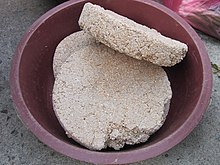Nuruk (Korean: 누룩) is a traditional Korean fermentation starter.[1][2][3][4] It is used to make various types of Korean alcoholic beverages including takju, cheongju, and soju.[3][5] It is an essential ingredient in Shindari and is mixed with rice.[6] Historically, it was used in a variety of provinces of Korea, including Jeju Island.

Wheat, rice (of both the glutinous and non-glutinous types), and barley are used to make nuruk, either as whole grain or in the form of grits or flour.[2][7] Wheat nuruk is the most common variety. The dry grain is moistened, shaped into a large cake, and hung up to ferment for 2‒4 weeks in an ondol room.[2][3][7] The cake matures at a precise temperature until a mold forms.[3]
Origin edit
Nuruk has been used in Korea since the period of the Three Kingdoms in the 3rd century CE, while similar fermentation starter, jiuqu, was first made in China during the Warring States period beginning in the 5th century BCE. Chinese history records the first use of nuruk in Korea in 1123 CE.[8]
Traditionally, nuruk was prepared on a small scale by families in summer or autumn, especially in July when the ambient temperature is between 20–30 °C (68–86 °F) on the Korean peninsula.[2][7] It has been mass-produced in factories since the 1920s.[9]
Characteristics edit
Microorganisms present in nuruk include Aspergillus oryzae, Rhizopus oryzae, lactic acid bacteria such as Lactobacilli, and yeasts, predominantly Pichia anomala and Saccharomyces cerevisiae.[2][7][10] Aspergillus provides the enzyme amylase, which saccharifies the rice's starches. The resulting sugars are consumed by the yeasts, producing alcohol, as well as the Lactobacilli, producing lactic acid. Rhizopus provides the enzyme protease and lipase, which break down the protein and fat in the outer layers of the rice grain (endosperm), allowing the amylase access to the starches in the inner part.[3][10]
The proportions of microorganisms can vary depending on the region where the nuruk was made. Nuruk made in the southern coastal areas surrounding Busan, for example, have a higher lactic acid bacteria content due to the warmer climate and humidity.[10]
Chemically, it contains 2,6-Dimethoxybenzoquinone (2,6-DMBQ), also found in fermented wheat germ extract.[11]
References edit
- ^ "Fermented Cereals a Global Perspective. Chapter 3." Fermented Cereals a Global Perspective. Chapter 3. Web. 04 Mar. 2016.
- ^ a b c d e Lee, Cherl-Ho (1999). "Cereal Fermentations in Countries of the Asia-Pacific Region". In Haard, Norman F.; Odunfa, S.A.; Lee, Cherl-Ho; Quintero-Ramírez, R.; Lorence-Quiñones, Argelia; Wacher-Radarte, Carmen (eds.). Fermented cereals : a global perspective. FAO Agricultural Services Bulletin. Rome: Food and Agriculture Organization. p. 91. ISBN 92-5-104296-9. ISSN 1010-1365. Retrieved 19 June 2017.
- ^ a b c d e Shin, Dong-Hwa; Kim, Young-Myoung; Park, Wan-Soo; Kim, Jae-Ho (2016). "Ethnic Fermented Foods and Beverages of Korea". In Tamang, Jyoti Prakash (ed.). Ethnic Fermented Foods and Alcoholic Beverages of Asia. India: Springer. p. 298. ISBN 9788132228004. Retrieved 23 September 2017.
- ^ McKay, Marianne; Buglass, Alan J.; Lee, Chang Gook (2011). "Fermented Beverages: Beers, Ciders, Wines and Related Drinks". In Buglass, Alan J. (ed.). Handbook of Alcoholic Beverages: Technical, Analytical and Nutritional Aspects. Chichester, UK: Wiley. pp. 214–216. ISBN 978-0-470-51202-9. Retrieved 23 September 2017.
- ^ Yoo, Jong-Gil. Nuruk, a Traditional Korean Fermentation Starter, contains the Bioactive Compound 2,6-dimethoxy-1,4-benzoquinone (2,6-DMBQ). Online.
- ^ Nowicki, Stephen. Holt McDougal Biology. Orlando, FL: Holt McDougal, 2012. Print.
- ^ a b c d Yokotsuka, T. (1985). "Fermented protein foods in the Orient, with emphasis on shoyu and miso in Japan". In Wood, Brian J. B. (ed.). Microbiology of Fermented Foods. Vol. 1. London: Elsevier Applied Science Publishers. pp. 197–247. ISBN 978-1-4613-7990-4.
- ^ "전통누룩의 역사". terms.naver.com. Retrieved 2016-03-16.
- ^ "Nuruk, a Traditional Korean Fermentation Starter, Contains the Bioactive." Ve Compound 2,6-dimethoxy-1,4-benzoquinone (2,6-DMBQ). Web. 16 Mar. 2016.
- ^ a b c Baldwin, Becca; Lenaghan, Daniel (2014). "Begin with Rice and Water: A Primer on Brewing Makgeolli." Iseo-myeon, Jeollabuk-do, South Korea: National Academy of Agricultural Science, Rural Development Administration. ISBN 978-0-470-51202-9. Retrieved 04 February 2019.
- ^ "누룩". terms.naver.com. Retrieved 2016-03-16.